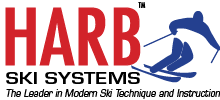In the original "Quick Improvement Series" posted on the PMTS forum, I discussed the similarities and differences between a very good PMTS skier and myself...

The two upper images are very similar and they are at almost the same place in the turn arc. The turn setup for both skiers is essentially the same.
The differences appear in the two lower images. Harald (in red & white) has dropped his hips lower into the turn and has achieved higher edge angles. As well, Harald has achieved greater vertical separation of the feet due to increased flexion of the inside leg.
How can you achieve these refinements?
* More aggressive bending (flexing) of the inside leg drops the hips closer to the slope, inside the arc of the turn
* Tipping the torso toward the stance ski to create more counterbalancing will keep you in balance as you achieve higher edge and tipping angles.
Diana and I discussed these images as well as the skiing of several other PMTS regulars. It's clear that the pelvis has a job to do in skiing and in achieving edge angles. The forces of a turn, generated by your ski edges on the snow, that allow your torso to be "inside" the turn, are transmitted up your stance leg into one hip socket. Because there is a separation between your hip socket and your spine it takes a torque around the stance hip to support the weight of your body.

Without this torque, indicated by the arrow in the image above, you would be unable to hold your hips level while balancing on one foot.
Try an exercise while facing a mirror. Stand on a block, book, or sturdy table so that your free leg (here, Harald's right) can hang without touching the floor. Put a band of string or elastic snugly around your hips so you can see the angle of the pelvis. Balance on one foot and see if you can keep the pelvis level (the elastic should be horizontal). Slowly lower the free side of the pelvis as though to lower your free foot to the floor. Don't flex the stance leg to achieve this; make sure that your elastic tilts. Then, slowly raise the free hip so that the free foot lifts away from the floor. Again, make sure that you are tilting the elastic.

Look at the influence of the angle of the pelvis while on edge. Note that the free leg is now Harald's left. We notice that many people obtain the pelvis angle shown in Frame A, even when they are working hard to tip and counterbalance. Fewer skiers are able to achieve the pelvis angle shown in Frame C.

Look again at the two lower images in the comparison at the top of the page. The skier on the left has his free hip lower than Harald's free hip. Harald has "tilted" his pelvis to keep it closer to horizontal; the pelvis is counterbalanced with the torso. The other skier's pelvis is leaned into the turn; it is not counterbalanced with the rest of the torso. Harald demonstrates the pelvis orientation of Frame C, while the other skier resembles Frame A.
[By Harald Harb; first published on our website on 28 October, 2006]



